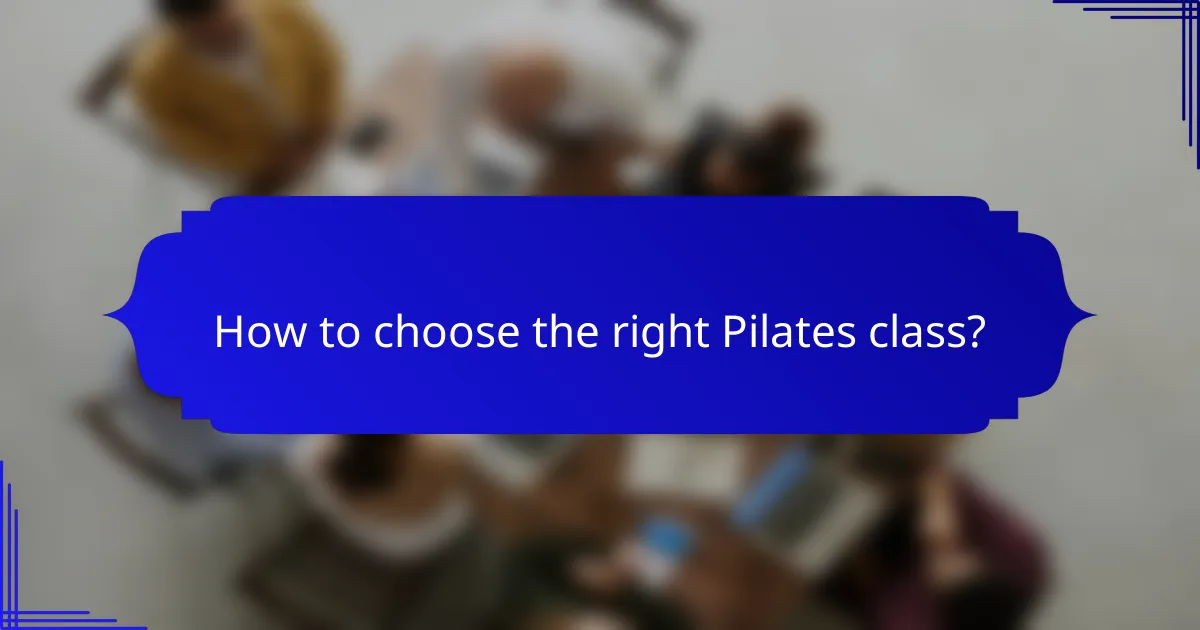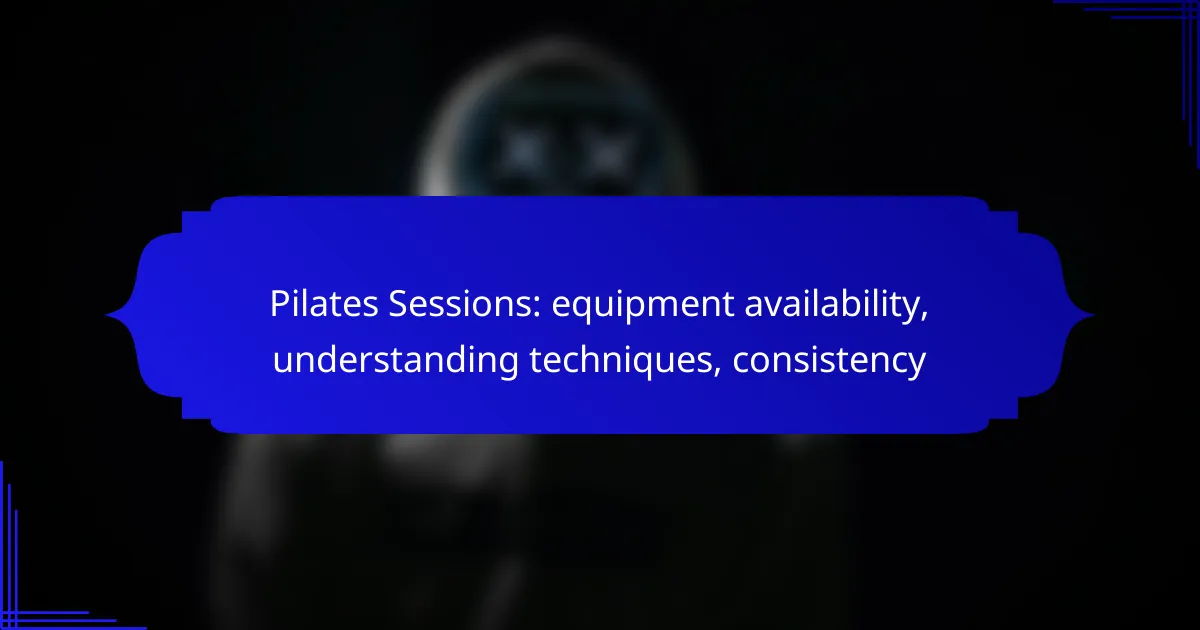Exploring Pilates sessions involves understanding equipment availability, mastering essential techniques, and maintaining a consistent practice. In Canada, various channels offer access to Pilates equipment, catering to different needs and budgets. For beginners, focusing on foundational techniques is crucial to developing body awareness and strength. Establishing a routine that fits your lifestyle will help ensure ongoing motivation and progress in your Pilates journey.

Where to find Pilates equipment in Canada?
In Canada, Pilates equipment can be found through various channels, including local fitness stores, online retailers, specialty studios, second-hand marketplaces, and manufacturer websites. Each option offers unique benefits, from immediate availability to potential cost savings.
Local fitness stores
Local fitness stores often carry a range of Pilates equipment, such as mats, resistance bands, and reformers. Visiting a store allows you to physically inspect the equipment and seek advice from knowledgeable staff. Look for stores that specialize in fitness to ensure a good selection.
Consider checking out well-known chains or independent shops in your area. Prices can vary significantly, so it’s wise to compare options before making a purchase.
Online retailers like Amazon
Online retailers, particularly Amazon, provide a vast selection of Pilates equipment, often at competitive prices. You can find everything from basic mats to advanced reformers with user reviews that help gauge quality. Shipping options are typically convenient, with many items available for quick delivery.
Be mindful of shipping costs and return policies when purchasing online. Look for sellers with good ratings to ensure a positive buying experience.
Specialty Pilates studios
Specialty Pilates studios not only offer classes but often sell equipment as well. Purchasing from a studio can provide the advantage of expert recommendations tailored to your needs. This option is ideal for those who want to invest in high-quality gear.
Some studios may also offer discounts or package deals for members, making it a cost-effective choice for regular practitioners.
Second-hand marketplaces
Second-hand marketplaces, such as Facebook Marketplace or Kijiji, can be excellent sources for affordable Pilates equipment. You might find gently used items at a fraction of the retail price. This option is particularly useful for those on a budget or looking for specific equipment.
When buying second-hand, inspect the equipment thoroughly and ask about its condition to avoid any surprises. Meeting in a public place for transactions is advisable for safety.
Manufacturer websites
Manufacturer websites often provide the most up-to-date information on Pilates equipment, including new releases and exclusive offers. Buying directly from manufacturers can ensure you receive authentic products and may include warranties or guarantees.
Check for promotions or discounts that manufacturers may offer directly to consumers, which can lead to savings compared to retail prices. Additionally, some manufacturers provide educational resources on how to use their equipment effectively.

What Pilates techniques should beginners learn?
Beginners in Pilates should focus on foundational techniques that enhance body awareness, flexibility, and strength. Key areas include basic mat exercises, reformer fundamentals, and effective breathing techniques to ensure a well-rounded practice.
Basic mat exercises
Basic mat exercises form the cornerstone of Pilates practice, emphasizing core strength and stability. Beginners should start with exercises like the Hundred, Roll-Up, and Single Leg Stretch to build foundational skills.
These exercises typically require minimal equipment, making them accessible for home practice. Aim for 10-15 repetitions per exercise, focusing on controlled movements and proper alignment.
Reformer fundamentals
The reformer is a versatile piece of equipment that adds resistance to Pilates workouts, enhancing strength and flexibility. Beginners should familiarize themselves with basic reformer exercises such as Footwork, Leg Circles, and the Short Box Series.
Classes often provide access to reformers, which can be beneficial for learning proper form. Start with one or two sessions per week to gradually build strength and confidence on the equipment.
Breathing techniques
Breathing techniques are essential in Pilates, helping to engage the core and enhance movement efficiency. Beginners should practice lateral breathing, which involves expanding the ribcage while keeping the abdomen engaged.
Incorporate breathing into exercises by inhaling during preparation and exhaling during exertion. This helps maintain focus and control, making movements more effective. Aim to practice these techniques consistently to develop a deeper connection with your body during sessions.

How to maintain consistency in Pilates practice?
To maintain consistency in Pilates practice, establish a routine that fits your lifestyle and keeps you motivated. Regular engagement with the exercises, whether through solo sessions or group classes, can significantly enhance your commitment and progress.
Setting a regular schedule
Creating a regular schedule is essential for consistency in Pilates. Aim for at least two to three sessions per week, ideally at the same times to build a habit. Consider your personal commitments and choose times when you feel most energized and focused.
Use a calendar or a fitness app to block out these times, treating them as unmissable appointments. This approach helps in prioritizing your practice and reduces the likelihood of skipping sessions.
Joining group classes
Joining group classes can enhance your consistency by providing structure and accountability. Many studios offer various classes throughout the week, allowing you to find one that fits your schedule. Participating in a community can also motivate you to attend regularly.
Look for classes that match your skill level and goals, whether you are a beginner or more advanced. Group settings often include instructors who can provide guidance and adjustments, improving your technique and keeping you engaged.
Tracking progress
Tracking your progress is crucial for maintaining consistency in Pilates. Keep a journal or use an app to log your workouts, noting the exercises performed, duration, and any improvements in strength or flexibility. This can help you stay motivated and see how far you’ve come.
Set specific, achievable goals, such as mastering a particular move or increasing your session duration. Regularly reviewing your progress can reinforce your commitment and highlight areas for further development, ensuring you stay on track with your practice.

What are the benefits of Pilates?
Pilates offers numerous benefits, including enhanced flexibility, core strength, and improved posture. These advantages contribute to overall physical health and can aid in injury prevention and rehabilitation.
Improved flexibility
Pilates focuses on controlled movements and stretching, which can significantly enhance flexibility over time. Regular practice encourages the elongation of muscles and increases the range of motion in joints.
To maximize flexibility gains, aim for at least two to three sessions per week. Incorporating stretches specific to your body’s needs can further improve results, especially for areas like the hips and spine.
Enhanced core strength
A key component of Pilates is its emphasis on core strength, which includes the muscles of the abdomen, lower back, and pelvis. Strengthening these muscles can lead to better stability and support for the spine.
Focus on exercises that engage the core, such as the Pilates hundred or the plank. Consistency is crucial; practicing Pilates regularly can lead to noticeable improvements in core strength within a few weeks.
Better posture
Pilates promotes awareness of body alignment and encourages proper posture through its exercises. By strengthening the core and back muscles, it helps individuals maintain a more upright and balanced stance.
To improve posture, incorporate exercises that target the upper back and shoulders. Being mindful of your posture during daily activities, such as sitting or standing, can further enhance the benefits gained from Pilates sessions.

How to choose the right Pilates class?
Choosing the right Pilates class involves evaluating instructor qualifications, class size, and the format of the sessions. Consider your personal goals and preferences to find a class that aligns with your needs.
Assessing instructor qualifications
When selecting a Pilates class, the instructor’s qualifications are crucial. Look for certifications from recognized organizations such as the Pilates Method Alliance or Balanced Body. Experienced instructors often have a background in anatomy or physical therapy, which can enhance your understanding of the techniques.
Additionally, consider the instructor’s teaching style and experience level. Some may focus on rehabilitation, while others emphasize fitness or athletic performance. Attend a trial class if possible to gauge their approach and ensure it matches your expectations.
Class size and environment
The size of the class can significantly impact your learning experience. Smaller classes typically offer more personalized attention, allowing instructors to correct your form and provide tailored feedback. Aim for classes with no more than 10 participants for optimal interaction.
The environment also matters. A clean, well-lit studio with appropriate equipment can enhance your comfort and focus. Check for amenities such as mats, props, and reformers, and ensure the space feels welcoming and conducive to practice.
Class format: mat vs. reformer
Understanding the difference between mat and reformer classes is essential in choosing the right Pilates session. Mat classes primarily use body weight and small props, focusing on core strength and flexibility. They are often more accessible and can be practiced anywhere.
Reformer classes utilize specialized equipment that provides resistance, allowing for a greater range of motion and varied exercises. This format can be beneficial for those looking to deepen their practice or rehabilitate injuries. Consider trying both formats to determine which aligns better with your fitness goals and preferences.
